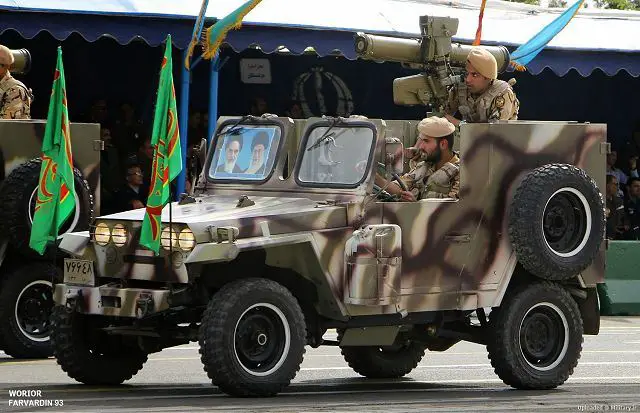|
|
|||
|
Defence & Security News - Iran
|
|||
|
|
|||
| Iran to continue local production of Russian anti-tank missiles 9M11 and 9M113. | |||
|
Iran was continuing the production of Russian anti-tank guided missiles (ATGM) 9M113 Konkurs (NATO designation AT-5 Spandrel and 9M111 (AT-4 Spigot) as of late 2015, according to the Stockholm International Peace Research Institute`s (SIPRI) arms transfer database.
|
|||
|
|
|||
 Iranian BMP-2 is armed with 9M111 At-4 Sipgot anti-tank missile. Iranian BMP-2 is armed with 9M111 At-4 Sipgot anti-tank missile. |
|||
|
|
|||
|
In 1996, Iran launched the serial production of 9M14/9M14M (NATO reporting name: AT-3 Sagger) Soviet/Russian ATGMs under the license provided by Russia. The missile was designated RAAD/I-RAAD respectively in Iranian Service. As of late 2015, Iran received approximately 4,550 RAAD/I-RAAD missiles.
Iran was also producing 9M111 Fagot (AT-4 Spigot) anti-tank missiles for BMP-2 and Boraq (a licensed copy of BMP-2) infantry fighting vehicles (IFV). The production was launched in 1993. As of late 2015, Iran got about 5,050 Fagot ATGMs. The 9M111 missile is used for the 9K111 Fagot second generation tube-launched SACLOS wire-guided anti-tank missile system which was developed by the Tula KBP Design Bureau for Instrument Building. The basic 9M111 (AT-4a 'Spigot') missile uses a 1.7 kg High Explosive Anti-Tank (HEAT) warhead which can penetrate up to 400 mm of conventional steel armour. The original man-portable firing post was the 22.5 kg 9P135 system with a 3 rds/min rate of fire. The 9P135 consists of a tripod, a 9S451 guidance controller box fitted to the tripod with an attachment for the missile canister immediately above and a9Sh119 optical sight unit attached to the left side of the launcher assembly. The 9M111 missile has a minimum range of only 70 meters and a maximum range of 2,000 meters. |
|||
|
|
|||
 Iranian Safir jeep armed with 9K113 Konkurs (NATO code AT-5 Spandrel) anti-tank missile system. Iranian Safir jeep armed with 9K113 Konkurs (NATO code AT-5 Spandrel) anti-tank missile system. |
|||
|
|
|||
|
The 9M113 Konkurs (AT-5 Spandrel) anti-tank missiles were also being manufactured by Iran under Towsan-1 designation. The production was launched in 1999. By late 2015, Iran had received approximately 2,900 9M113 anti-tank missiles.
The 9K113 Konkurs (NATO code AT-5 Spandrel) is Russian-made Semi-automatic command to line of sight (SACLOS) wire-guided anti-tank missile. The missile was designed and developed by the Russian Defense Company KBP (Konstruktorskoe Buro Priborostroeniya). The 9M113M missile has a tandem warhead with an extended nose probe to defeat explosive reactive armour before the main warhead initiates to penetrate 750 to 800mm of main armour. The Konkurs has a maximum range of 4,000 meters and a minimum range of 100 meters. The operating temperature range is from –50°C to +50°C. |
|||
|
|
|||
|
© Copyright 2016 TASS. All rights reserved. This material may not be published, broadcast, rewritten or redistributed.
|
|||
Iran to continue local production of Russian anti-tank missiles 9M11 and 9M113 TASS 10603161
- Posted On














